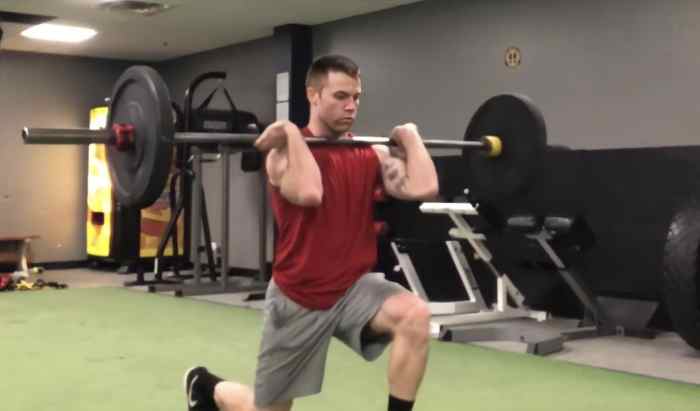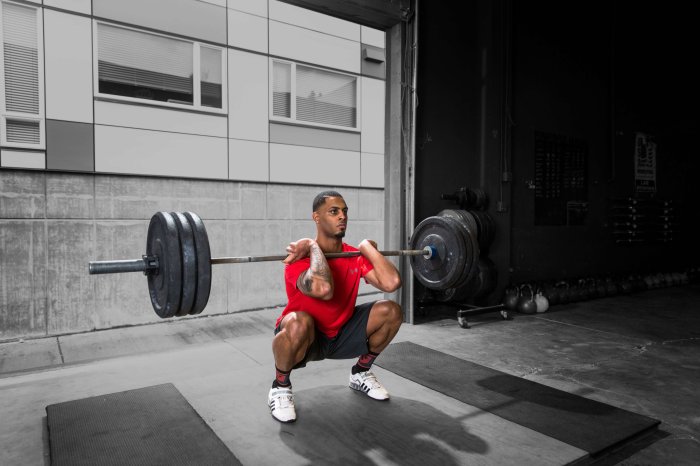Football strength training is the cornerstone of success on the gridiron, propelling players to reach their full potential and excel in the demanding world of football. Embark on a journey to explore the benefits, exercises, and strategies that empower athletes to dominate the field.
Through rigorous training, players enhance their power, speed, and agility, while reducing the risk of injuries. This guide unveils the secrets of effective strength training, providing a comprehensive blueprint for coaches, athletes, and enthusiasts alike.
Types of Strength Training Exercises
Strength training is a fundamental component of football, as it enhances athletic performance, reduces the risk of injuries, and improves overall fitness. To achieve optimal results, it’s crucial to incorporate a variety of exercises that target different muscle groups. Here’s a comprehensive list of strength training exercises commonly used in football, categorized by the muscle groups they primarily engage:
Upper Body Exercises
Chest
- Bench Press:Develops chest strength, essential for pushing off opponents and blocking.
- Incline Dumbbell Press:Targets the upper chest, crucial for catching passes over the head.
- Push-Ups:Compound exercise that strengthens the chest, shoulders, and triceps.
Shoulders
- Overhead Press:Strengthens the shoulders, important for tackling and maintaining stability.
- Lateral Raises:Isolates the lateral deltoids, enhancing shoulder abduction.
- Front Raises:Targets the anterior deltoids, responsible for raising the arms in front of the body.
Back
- Barbell Row:Develops back strength, crucial for pulling opponents and maintaining posture.
- Pull-Ups:Compound exercise that strengthens the back, biceps, and forearms.
- Deadlifts:Full-body exercise that primarily targets the back and hamstrings, improving overall strength and power.
Arms
- Bicep Curls:Isolates the biceps, important for gripping the ball and tackling.
- Tricep Extensions:Strengthens the triceps, crucial for pushing off opponents and extending the elbows.
- Hammer Curls:Targets the brachioradialis, enhancing wrist stability and grip strength.
Lower Body Exercises
Quads
- Squats:Compound exercise that develops quad strength, essential for running, jumping, and tackling.
- Leg Press:Machine-based exercise that isolates the quads, improving knee extension power.
- Lunges:Single-leg exercise that strengthens the quads, glutes, and hamstrings.
Hamstrings
- Hamstring Curls:Isolates the hamstrings, important for running, jumping, and tackling.
- Glute Bridges:Compound exercise that strengthens the hamstrings, glutes, and lower back.
- Romanian Deadlifts:Targets the hamstrings and glutes, enhancing hip extension power.
Calves
- Calf Raises:Isolates the calf muscles, crucial for running, jumping, and maintaining balance.
- Heel Raises:Single-leg exercise that targets the calf muscles, improving ankle stability.
- Toe Raises:Isolates the gastrocnemius muscle, enhancing toe flexion power.
Core
- Planks:Static exercise that strengthens the abdominal and back muscles, improving core stability.
- Crunches:Compound exercise that targets the abdominal muscles, enhancing flexion.
- Russian Twists:Dynamic exercise that strengthens the oblique muscles, improving rotational stability.
– Provide a comprehensive list of exercises for each muscle group, including primary and secondary movements.
Building strength requires a well-rounded approach that targets all major muscle groups. Each group has specific primary and secondary movements that effectively develop strength and power.
Chest
- Primary: Barbell bench press, dumbbell bench press
- Secondary: Incline dumbbell press, decline dumbbell press, chest flyes
Shoulders
- Primary: Overhead press, lateral raise
- Secondary: Front raise, reverse fly, upright row
Back
- Primary: Barbell row, pull-up
- Secondary: Dumbbell row, lat pulldown, seated row
Legs
- Primary: Squat, leg press, deadlift
- Secondary: Hamstring curl, leg extension, calf raise
Core
- Primary: Plank, crunch, Russian twist
- Secondary: Side plank, leg raise, bicycle crunch
Periodization in Strength Training for Football
Periodization is a structured approach to strength training that involves manipulating training variables over time to optimize performance. It is based on the principle of progressive overload, which states that muscles must be gradually challenged to continue adapting and growing.
Linear Periodization
Linear periodization is a simple and straightforward approach that involves gradually increasing the weight, sets, and repetitions over time. This method is easy to implement and can be effective for beginners or those who are new to strength training.
Block Periodization
Block periodization involves dividing the training year into distinct blocks, each with a specific focus. For example, one block might focus on strength development, while another might focus on power or hypertrophy. This method allows for more specific training and can be more effective than linear periodization for experienced lifters.
Undulating Periodization
Undulating periodization involves varying the training variables within each workout or week. This method can help to prevent plateaus and keep the training stimulus fresh. Undulating periodization is often used by advanced lifters.
| Periodization Model | Key Components |
|---|---|
| Linear Periodization | Gradual increase in weight, sets, and repetitions |
| Block Periodization | Division of training year into distinct blocks with specific focus |
| Undulating Periodization | Variation of training variables within each workout or week |
Periodization can help football players improve their strength and performance by:
- Optimizing the training stimulus for each phase of the season
- Preventing plateaus and keeping the training fresh
- Reducing the risk of injury
Nutrition for Football Strength Training
Proper nutrition is essential for supporting strength training in football players. It provides the body with the necessary fuel and building blocks to repair and rebuild muscle tissue, enhance performance, and support overall health.Macronutrient needs, hydration, and supplementation are key aspects of a well-balanced nutrition plan for football strength training.
Macronutrients, including carbohydrates, protein, and fats, provide the body with energy and support muscle growth and repair. Carbohydrates are the primary source of energy during intense exercise, while protein is essential for muscle growth and recovery. Fats provide energy and support hormone production.Hydration is crucial for maintaining optimal performance during strength training.
Dehydration can lead to fatigue, decreased strength, and impaired recovery. Football players should aim to consume plenty of fluids, especially water and sports drinks, before, during, and after workouts.Supplementation can be beneficial for football players engaged in strength training, but it should be used under the guidance of a qualified healthcare professional.
Some supplements, such as creatine and protein powder, can support muscle growth and recovery. However, it’s important to note that supplements are not a substitute for a balanced diet.
Recovery and Regeneration

Recovery and regeneration are crucial for football players undergoing strength training to maximize performance and prevent injuries. They enable muscles to repair, rebuild, and adapt to the demands of training, ensuring optimal physical condition and readiness for game day.
Active Recovery
Active recovery involves engaging in low-intensity activities that promote blood flow and circulation, aiding in muscle recovery. Examples include light cardio, yoga, or walking.
Monitoring and Assessment
Tracking progress in football strength training is crucial for evaluating effectiveness and making necessary adjustments. Several methods are used for monitoring and assessment:
Fitness Tests:Fitness tests measure various physical attributes relevant to football, such as speed, agility, power, and endurance. These tests can be conducted at different intervals to assess improvements and identify areas for improvement. Common fitness tests include:
- 40-yard dash
- Vertical jump
- Bench press
- Squat
- Shuttle run
Body Composition Measurements:Body composition measurements assess the ratio of fat mass to lean mass. Methods like skinfold measurements, bioelectrical impedance analysis (BIA), or hydrostatic weighing can be used to determine body fat percentage, muscle mass, and hydration levels. Tracking body composition helps ensure that strength training is not leading to excessive weight gain or muscle loss.
Performance Metrics:Performance metrics evaluate specific football-related skills and abilities. These metrics can include game statistics (e.g., tackles, yards gained), practice performance (e.g., number of reps completed), or drills (e.g., cone drills). Monitoring performance metrics helps assess the impact of strength training on on-field performance.
Safety Considerations

Football strength training involves demanding physical activities that require proper safety measures to prevent injuries. Adhering to safety guidelines is crucial for ensuring the well-being of athletes.
Maintaining proper form is paramount in every exercise. Incorrect form can strain muscles and joints, increasing the risk of injuries. Warming up before training prepares the body for strenuous activities, reducing the likelihood of muscle pulls or tears. Similarly, cooling down after training aids in muscle recovery and prevents stiffness.
Injury Prevention Strategies
- Use appropriate weight: Lifting too much weight can lead to injuries. Start with a weight that challenges you but allows you to maintain good form.
- Focus on technique: Proper technique is essential for injury prevention. Work with a qualified coach to learn the correct form for each exercise.
- Listen to your body: If you experience pain, stop the exercise and consult with a medical professional. Pushing through pain can worsen injuries.
- Warm up and cool down: Warming up prepares your body for exercise, while cooling down helps your body recover. Both can reduce the risk of injuries.
| Area | Safety Measures |
|---|---|
| Form | Maintain proper technique to avoid injuries. |
| Warm-up | Prepare the body for strenuous activities. |
| Cool-down | Aid in muscle recovery and prevent stiffness. |
| Weight | Use appropriate weight to challenge yourself without compromising form. |
| Pain | Stop the exercise and consult a medical professional if you experience pain. |
Technology in Football Strength Training
Technology has revolutionized the way football players train for strength. Wearable devices, motion capture systems, and other tools are now being used to enhance training effectiveness, improve performance, and reduce the risk of injury.
Wearable Devices
Wearable devices, such as GPS trackers and heart rate monitors, can provide real-time data on a player’s activity levels, heart rate, and other metrics. This information can be used to monitor training intensity, track progress, and identify areas for improvement.
Motion Capture Systems
Motion capture systems use sensors to track the movement of a player’s body. This data can be used to analyze technique, identify imbalances, and develop personalized training programs.
Benefits of Using Technology in Football Strength Training
- Enhanced training effectiveness
- Improved performance
- Reduced risk of injury
- Personalized training programs
Limitations of Using Technology in Football Strength Training
- Cost
- Complexity
- Reliability
Emerging Trends and Future Directions
The use of technology in football strength training is still in its early stages, but it is rapidly evolving. Emerging trends include the use of artificial intelligence (AI) to analyze data and provide personalized training recommendations, and the development of wearable devices that can track more complex metrics, such as muscle activation and fatigue.
Conclusion
Technology is playing an increasingly important role in football strength training. Wearable devices, motion capture systems, and other tools can enhance training effectiveness, improve performance, and reduce the risk of injury. As technology continues to evolve, it is likely that we will see even more innovative and effective ways to use technology to train football players.
Integration with Other Training Components

Strength training is a vital part of football training, but it should be integrated with other components to optimize performance. Balancing strength training with speed training, agility drills, and game simulations is crucial.
Frequency and Duration
Strength training sessions should be scheduled 2-3 times per week during the pre-season and in-season. Off-season strength training can be more frequent, up to 4-5 times per week. Each session should last approximately 60-90 minutes.
Exercise Selection and Intensity, Football strength training
Exercises should target all major muscle groups and include both primary and secondary movements. Intensity should be adjusted based on the phase of the season and the athlete’s fitness level.
Recovery and Nutrition
Adequate recovery time between strength training sessions and proper nutrition are essential for muscle growth and repair. Athletes should consume sufficient protein and carbohydrates to support their training efforts.
Integration Examples
Pre-season:Focus on building strength and power through heavy compound lifts and plyometric exercises. Integrate speed drills and agility work into training sessions. In-season:Maintain strength levels while reducing volume and intensity. Incorporate game simulations to practice specific movements and tactics. Off-season:Increase training frequency and intensity to improve strength and power.
Include more variety in exercises and focus on developing muscular endurance.
Injury Prevention and Rehabilitation
Strength training can help prevent injuries by strengthening muscles and improving joint stability. It also plays a crucial role in rehabilitation by restoring muscle function and range of motion after an injury.
Future Trends in Football Strength Training
The world of football strength training is constantly evolving, with new trends and innovations emerging all the time. These trends are driven by the desire to improve player performance, reduce injuries, and gain a competitive edge.
One of the most significant trends in football strength training is the increasing use of technology. Technology can be used to track player performance, monitor progress, and provide feedback. This information can then be used to tailor training programs to the individual needs of each player.
Another trend in football strength training is the focus on functional movements. Functional movements are exercises that mimic the movements that players perform on the field. This type of training helps to improve player performance and reduce the risk of injuries.
Finally, there is a growing trend towards personalized training programs. These programs are designed to meet the specific needs of each player. This type of training can help players to maximize their potential and reach their full potential.
Emerging Trends
- Increased use of technology:Technology can be used to track player performance, monitor progress, and provide feedback. This information can then be used to tailor training programs to the individual needs of each player.
- Focus on functional movements:Functional movements are exercises that mimic the movements that players perform on the field. This type of training helps to improve player performance and reduce the risk of injuries.
- Personalized training programs:These programs are designed to meet the specific needs of each player. This type of training can help players to maximize their potential and reach their full potential.
Potential Impact
These trends are likely to have a significant impact on the future of football strength training. As technology continues to develop, we can expect to see even more innovative and effective training methods emerge. The focus on functional movements will help to improve player performance and reduce the risk of injuries.
And personalized training programs will allow players to reach their full potential.
Case Studies of Successful Football Strength Training Programs

Successful football strength training programs share common characteristics that contribute to their effectiveness. By examining these case studies, we can identify key principles that guide successful implementation.
One notable case study is the University of Alabama’s strength and conditioning program, which has consistently produced elite football players under the leadership of coach Nick Saban. Their program emphasizes a comprehensive approach that combines strength training, speed development, and injury prevention.
Key Factors for Success
- Individualized Training:Tailoring programs to the specific needs and abilities of each athlete.
- Progressive Overload:Gradually increasing the intensity and volume of training to challenge athletes and promote adaptation.
- Emphasis on Compound Movements:Exercises that engage multiple muscle groups simultaneously, maximizing efficiency and effectiveness.
- Periodized Approach:Dividing the training year into distinct phases with specific goals, such as strength building, speed development, and maintenance.
- Integration with Other Training Components:Coordinating strength training with other aspects of football training, such as speed drills and team practice.
- Data-Driven Decision Making:Using objective measures, such as strength testing and GPS tracking, to monitor progress and adjust training accordingly.
- Collaboration with Sports Medicine:Working closely with medical professionals to ensure athlete safety and address any injuries promptly.
Final Summary: Football Strength Training
Football strength training is not merely a means to improve physical attributes; it’s an investment in the success of the team. By incorporating these principles into their training regimen, players and coaches can unlock the full potential of their athletes, leading them to victory and achieving their gridiron dreams.
FAQ Summary
What are the primary benefits of strength training for football players?
Strength training enhances power, speed, agility, and reduces the risk of injuries.
How often should football players engage in strength training?
The frequency of strength training sessions depends on the individual’s fitness level and goals, but generally 2-3 sessions per week are recommended.
What are some common mistakes to avoid when performing strength training exercises?
Improper form, lifting too much weight, and neglecting warm-ups and cool-downs are common mistakes to avoid.
Leave a Reply